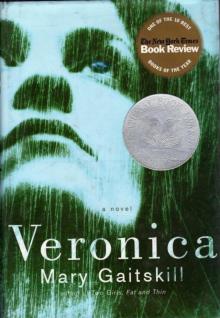Read Veronica Storyline:
From Publishers WeeklyStarred Review. [Signature]Reviewed by Heidi JulavitsImagine that Edie Sedgwick penned a roman à clef in her 50s, and that she discovered, in her ugly, diseased decrepitude, that celebrities and downtown loft spaces and skuzzy rich hangers-on were the nadir of existence. Imagine that she managed, in her own post–trauma-addled way, to convey a beautiful-ugly portrait of this life, and the life that followed that life, a life of cleaning offices and riding public buses, in a wincingly acute manner that allowed you not only to forgive the destructiveness in which her youthful self luxuriated but view it as a real human tragedy. This is the accomplishment of Veronica, or rather of Alison, who is the narrator and soul-wearied subject of Mary Gaitskill's second novel. Alison, who lived an Edie-ish life, has a face that is "broken, with age and pain coming through the cracks." Now in her 50s, she cleans her friend's toilet for money, she's sick with hepatitis and her "focus sometimes slips and goes funny";an apt description of her story's pleasing disorientation, a story which amounts to a nonchronological recounting of her "bright and scalding" past as she hikes feverishly up a hill. Alison's narration begins as a bracing account of her "gray present" from which she recalls her childhood and her years as a model in Paris and New York and the death of her friend Veronica from AIDS. A former inhabitant of a face-deep world, she cannot describe a person without first reducing his or her face to a single violent visual stroke ("his face was like lava turned into cold rock"). These descriptions;or dismissals;fail, on purpose, to render any character a visual flesh-and-blood presence; instead, Alison's way of seeing renders people distressingly naked. Of course no seasoned reader of Mary Gaitskill would expect a preeningly tragic book about the emotional pitfalls of modeling, and so where there might be an airbrushed homage to failing beauty or weepy nostalgia over formerly elastic body parts there are instead turds, sphincters, scars, wounds and other celebrated repugnancies. Gaitskill's style is gorgeously caustic and penetrating with a homing instinct toward the harrowing; her ability to capture abstract feelings and sensations with a precise and unexpected metaphor is a squirmy delight to encounter in such abundance. As the book progresses, Alison's gray present becomes subsumed by the scalding brightness of her past, until her sick and ugly self is all but obliterated from the pages; aside from the occasional reminder that Alison is climbing a hill, her sage hindsight collapses into the immediacy of her recollections, and Alison's shallow bohemian fixations again become her only story. The result is that her blunt honesty feels face, rather than soul, deep. It is hard to convey the tragedy of a girl in the prime of her beauty who savors the ugly way she experiences herself; it is more wrenching, and more in keeping with the gimlet-eyed clarity of the book's earlier pages, to convey the tragedy of the truly ugly woman, who once, despite her demurrals and insecurities, knew beauty. (On sale Oct. 11)Heidi Julavits is the author of two novels, The Mineral Palace and The Effect of Living Backwards. She is a founding editor of the Believer. Copyright © Reed Business Information, a division of Reed Elsevier Inc. All rights reserved. From The New YorkerGaitskill's second novel is narrated over the course of a single day by an ailing former fashion model named Alison, now cleaning offices for a living, who ruminates on her glamorous youth and on her friendship with an older woman who died of AIDS. Her recollections range through the bohemian San Francisco of the late nineteen-seventies, the fashion worlds of Paris and New York in the eighties, and her family's claustrophobic but comforting home in suburban New Jersey. Gaitskill's distinctive prose often traverses decades and continents in a single paragraph, in a way that is more montage than narrative. When this ambitious approach succeeds, it yields startling revelations; when it doesn't quite come off, the result is a pleasant muddle. Recalling San Francisco prostitutes, Alison says, "Most of them weren't beautiful girls, but they had a special luster." An analogous allure pervades this book. Copyright © 2005 The New YorkerPages of Veronica :
